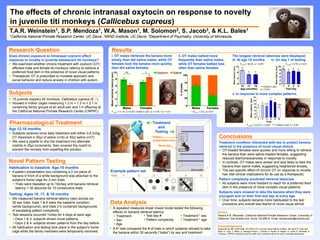
TWeinstein_Poster_ASP2014
- 1. T.A.R. Weinstein1, S.P. Mendoza1, W.A. Mason1, M. Solomon2, S. Jacob3, & K.L. Bales1 1California National Primate Research Center, UC Davis; 2MIND Institute, UC Davis; 3Department of Psychiatry, University of Minnesota. Research Question We examined whether chronic treatment with oxytocin (OT) affected male and female titi monkeys’ latency to retrieve a preferred food item in the presence of novel visual patterns. Therapeutic OT is prescribed to increase approach and social behavior and reduce anxiety in children with autism. Age 12-18 months Subjects received once daily treatment with either 0.8 IU/kg OT dissolved in 50μl of saline (n=8) or 50μl saline (n=7). We used a pipette to drip the treatment into alternate nostrils in 25μl increments, then covered the nostril to prevent the monkey from expelling the solution. Habituation to baseline: Age 15 months A pattern presentation box containing a 2 cm piece of banana in front of a white background was attached to the subject’s home cage for 3-min trials. Trials were repeated up to 10x/day until banana retrieval latency < 30 seconds for 10 consecutive trials. Testing: Ages 15, 17, & 19 months We measured banana retrieval latency (sec) across six 30-sec trials: trials 1 & 6 were the baseline condition (white background), and trials 2-5 contained backgrounds of escalating pattern complexity. Test sessions occurred 1x/day for 4 days at each age: Days 1 & 3: subjects shown novel patterns. Days 2 & 4: subjects shown patterns from the day before. All habituation and testing took place in the subject’s home cage while the family members were temporarily removed. Pharmacological Treatment OT-treated females were quicker and more willing to retrieve the banana than were saline-treated females, suggesting reduced fearfulness/anxiety in response to novelty. In contrast, OT males were slower and less likely to take the banana than saline males, suggesting heightened anxiety. The sex-specific effect of chronic OT on response to novelty has vital clinical implications for its use as a therapeutic. Pattern complexity predicted retrieval latencies. All subjects were more hesitant to reach for a preferred food item in the presence of more complex visual patterns. Subjects were slowest to take the banana when they were youngest and on their first test day at every age. Over time, subjects became more habituated to the test procedure and overall less fearful of novel visual stimuli. Conclusions Results i. OT males retrieved the banana more slowly than did saline males, while OT females took the banana more quickly than did saline females. The longest retrieval latencies were displayed: iii. At age 15 months iv. On day 1 of testing Subjects 15 juvenile coppery titi monkeys, Callicebus cupreus (8 ♂). Housed in indoor cages measuring 1.2 m × 1.2 m × 2.1 m containing family groups of an adult pair and 1-4 offspring at the California National Primate Research Center (CNPRC). Treatment condition interacted with sex to predict banana retrieval in the presence of novel visual stimuli. Acknowledgements Supported by NIH HD071998, P51OD011107, and the Good Nature Institute. We thank R. Arias Del Razo, S. Carp, C. Blanz, E. Sahagun Parez, L. Goetze, C. Nuñez, B. Ragen, R. Larke, E. Rothwell, S. Freeman, CNPRC husbandry and vet staff, and countless interns for their invaluable assistance. Contact Tamara A.R. Weinstein, California National Primate Research Center, University of California, One Shields Ave, Davis, CA 95616. Email: tarweinstein@ucdavis.edu Does chronic exposure to intranasal oxytocin affect response to novelty in juvenile-adolescent titi monkeys? F1,187 = 11.14, p = 0.001; Fisher’s LSD, *p < 0.05 **p < 0.01 * Χ2 df = 1 > 6.3, p ≤ 0.01 Oxytocin Saline The effects of chronic intranasal oxytocin on response to novelty in juvenile titi monkeys (Callicebus cupreus) Novel Pattern Testing Example pattern set Trial: 1 2 3 4 5 6 Treatment and Testing Pattern presentation box Perch bar Not to scale A repeated measures linear mixed model tested the following effects on banana retrieval latency: Treatment Sex Age Treatment * sex Treatment * age Data Analysis A Χ2 test compared the # of trials in which subjects refused to take the banana within 30 seconds (“balks”) by sex and treatment. Test day # Pattern complexity ii. OT males balked more frequently than saline males, while OT females balked less often than saline females. v. In response to more complex patterns. Males Females 0 2 4 6 8 10 Meanretrievallatency(sec) ** * 15 17 19 0 4 8 12 Age (months) Meanlatency(sec) a b b 1 2 3 4 0 2 4 6 8 10 Test Day Meanlatency(sec) a b b b 1 2 3 4 5 6 0 2 4 6 8 10 12 Trial MeanLatency(sec) a a,b b a,b c c F2,210 = 20.43, p < 0.001 a,b Fisher’s LSD, p < 0.001 F3,333 = 3.79, p = 0.01 F5,555 = 14.23, p < 0.001 a,b,c Fisher’s LSD, p < 0.05 Males Females 0 25 50 75 100 * * %ofbalks